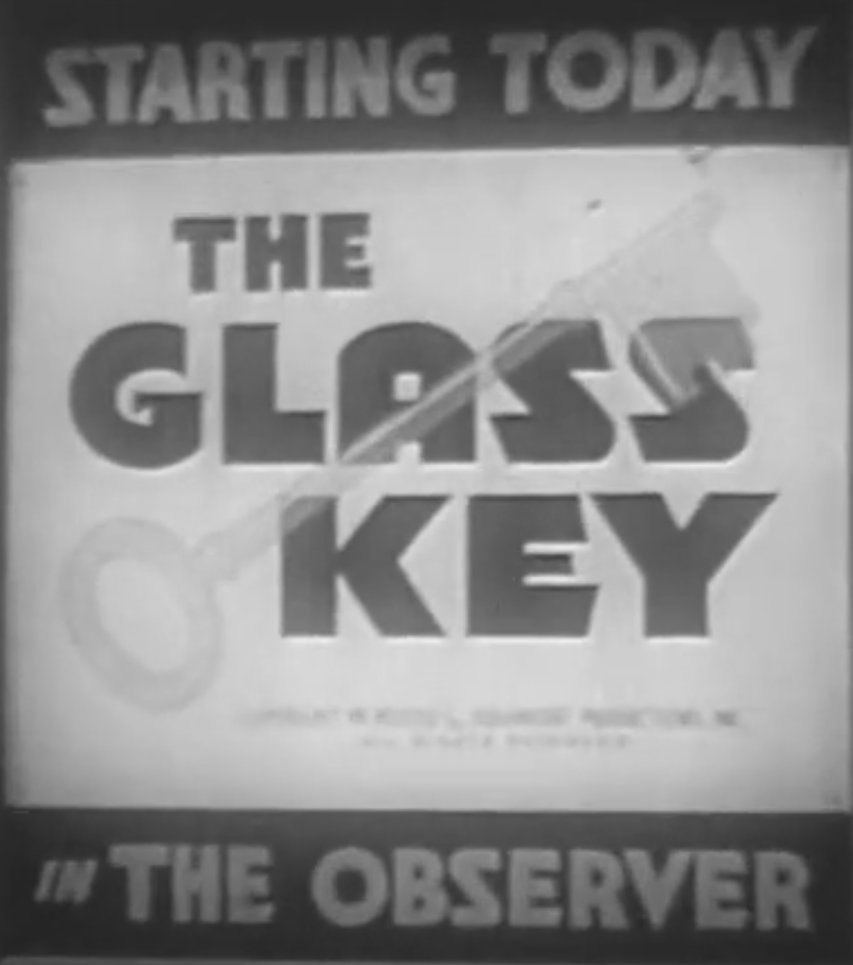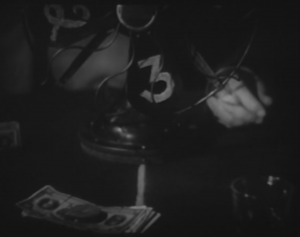Supplemental to Monday Book Report

Just watched the 1935 film version of Hammett’s novel The Glass Key, which I mentioned in yesterday’s book report. I had never seen the short (just over 1-¼ hours) movie starring George Raft, and wanted to see how it compared with the 1942 remake featuring Alan Ladd and Veronica Lake. The latter film had always disappointed me, since I am in love with the original book and felt that, though the plots of the book and the 1942 movie are nearly identical, the Alan Ladd vehicle just never seemed to gel together—maybe I should say that it just congealed into a inharmonious mess. So I had quite restrained hopes as I started watching the first film version of 1935, four years after the publication of the novel.
George Raft exceeded those hopes and excelled as Ned—excuse me—Ed* Beaumont, the fixer and all-around go-to guy for political boss Paul Madvig, here played ably by the stalwart Edward Arnold. Raft is letter-perfect as the fast-talking, faster-thinking gambler who plays his cards close to his chest, speaking only with his mouth while his face says nothing, just his flashing eyes giving evidence of the wheels turning behind his outwardly calm visage. Where Ladd played the part slightly louche, Raft portrays the clever sharper always trying to stay two steps ahead of everyone else in the game. He nails the character of Beaumont and his actions in the demimonde of corrupt small city politics, and brings to life a figure who could have grown up in the hardscrabble world of Hell’s Kitchen, as Raft did in real life.

But even in the first scene introducing Ned—sorry, I only finished the novel yesterday and can’t help thinking of… well, never mind—Ed Beaumont early signs of movie problems appear. The novel opens with Ned on a losing streak, a gambler behind the eight ball who’s been picking ’em wrong for weeks. Our movie’s Ed, on the other hand, is introduced winning (at a fun game where bets are placed on which blade of a fan will stop at the bottom when the fan is turned off) and he keeps on winning throughout the film, never losing a single bet. This small change is indicative of divergences from the original that will eventually pull the movie so far off course from the original book that it lands at an entirely different destination, with a thud.
The movie opens with a horrifying car wreck†, which is the necessary but not sufficient motive for the unraveling of boss Madvig’s power. You see, the driver of the killer car is a staunch Madvig supporter, and he and his brother-in-law expect his boss to fix this little accident up as undoubtedly has been done before. Madvig refuses, however, because of the upcoming election which cannot be endangered by blowback from something even as minor as suppressing a vehicular manslaughter charge. This refusal comes back to haunt the Madvig machine (here called a ‘Voters League’—the book has the boss working out of either his Log Cabin Club or the East State Construction & Contracting Company he also owns) when Taylor Henry is murdered under murky circumstances. Taylor (played in his brief scenes by Ray Milland in an early role) is the son of Senator John T. Henry, a Madvig candidate, and the political boss was seen arguing with the boy shortly before his death by the brother-in-law who Madvig wouldn’t help earlier. Madvig’s enemy, Shad O’Rory, uses the witness testimony and other sources of dirt in his own newspaper, The Observer, to tie Madvig to the murder in hopes of bring down his political machine. Oh, and Paul Madvig is in love with Senator Henry’s daughter, who doesn’t love him.
This seemingly complicated plot is actually handled quite well (with several more complications) in the film, and I initially approved of many of the changes from the book to the film, seeing a cinematographic necessity as well as a speedy pace that required the usual truncations, replacements, and graftings in a movie adaptation of a book. (What happened to Deckard’s wife between Do Androids Dream Of Electric Sheep? and Blade Runner, for example?) More of the novel’s plot shows up onscreen in the 1942 version, like the weird confrontation at the house of The Observer‘s editor, but the raw-boned detachment of Ned or Ed Beaumont comes through much more successfully in this 1935 original. The chemistry between George Raft and Edward Arnold is also sharper and more believable in this earlier version than that between Alan Ladd and Brian Donleavy, who portrayed Madvig in the later film. And the mother of Madvig—who I don’t think even appears in the 1942 film—is played brilliantly by Emma Dunn, and steals almost all of her scenes, except the last one.

Because two big changes happened between the publication of the novel in 1931 and the release of this movie in 1935: the end of Prohibition (1933) and enforcement of the Hays Code (1934). The climatic scene of the story takes place in a bar, not a speakeasy, and the patina of easy crime and corruption which seems omnipresent in the novel is watered down like the whisky Ned gets served in the book. The failed suppression of vice portrayed in the novel is foiled by the successful censorship of the reality of crime and evil in the movie, leaving us a story washed over with calcimine.
(Aside: Another change between book and movie, this one just pointless to me, unless George Raft asked for it, is that the Beaumont character always orders rye, instead of the scotch he habitually drinks in Hammett’s novel. This is particularly noticeable and hence galling, in the very fight scene just mentioned, at the beginning of which Ed Beaumont orders rye while his drunken companion orders scotch, in a complete inversion of the novel. Also, why does Raft have to punch a woman? That, too, was jarring, and more than jarring, unnecessary from sheerly a story point of view.)
Though the crucial, almost masochistic beating in the novel makes an appearance in the movie, the effects of which are shown by Raft’s fine acting rather than makeup, the easy sexual charm and cunning of Beaumont are missing entirely from the 1935 film. In this regard the film loses both to the book and to the 1942 remake, which at least had the tension between Alan Ladd and Veronica Lake (who played the part of the Senator’s daughter). The two main female protagonists in the original film version are almost non-entities, though they do wear clothes well. (Not so well as Veronica Lake, but then, who does?) The erasure of a prime plot point—the anonymous letters about the Taylor Henry murder which drive much of the action of the novel—leaves the film choppy and drastic, as if scenes were missing from the version we’re watching. And then, to top it all off, the finale has to invoke the old ‘let’s gather all the prime suspects and solve the crime’ trope of English mysteries, leaving us with a last reel of the movie almost unrelated to anything which came before.
The final scene, which I won’t reveal, reduces the goodwill created by Raft and Arnold’s fine acting to rubble, and left me with a sour taste in my mouth, as if I’d just eaten cotton candy made from spoiled milk.
Still, it is pretty short. You could waste your time in worse ways, say in playing yet another series of sudoku games on your phone.
* For reasons unclear to me, both film versions change the first name of the protagonist from ‘Ned’ to ‘Ed’.
† Though the car crash scene is truly well-done, one of the most visceral and frightening I’ve seen, perhaps it presages in the beginning the wreck this movie becomes at the end.
Leave a comment